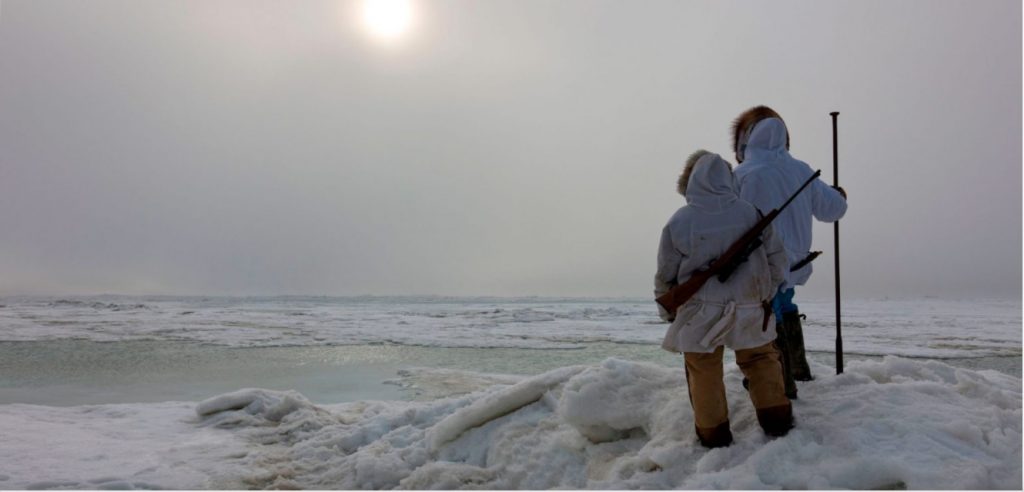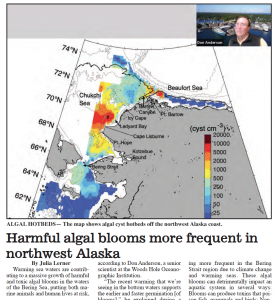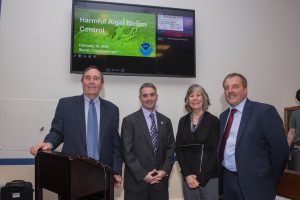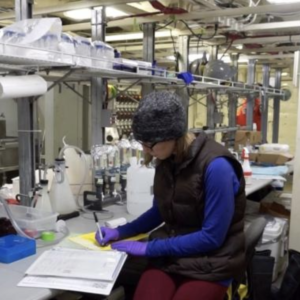News
A news story in Nome, Alaska on April 2022 featured research on algal toxin levels in the marine food web. The full story in the Nome Nugget is available here.
A story in the Cape Cod Times on Feb. 2, 2022 covered harmful algal blooms (HABs) in Cape Cod waters. “What you are seeing on the Cape is decades of problems with septic systems,” said Anderson. Groundwater travels slowly and even if the entire Cape was sewered today and no more nitrogen or phosphorus entered groundwater, there is a big reservoir of nutrients that will reach ponds and marine embayments for decades to come and a lot more already stored in bottom sediments. Meanwhile the temperature is going up and these species are doing very well,” The full story is available here.
Hakai Magazine interviewed research biologists Evie Fachon at WHOI and Kathi Lefebvre at the NOAA Northwest Fisheries Science Center in Seattle, Washington for an article focusing on the potential for a significant increase in Alexandrium catenella harmful algal blooms due to warming Arctic waters. Alexandrium catenella blooms produce saxitoxin, a neurotoxin that paralyzes the nervous system in wildlife and humans and cannot be removed by cooking or freezing, thus raising serious concerns for food security for Native Alaskan communities that rely on wild harvests.

The arrival of toxin-producing Alexandrium catenella blooms in Alaska’s Arctic is a dangerous sign for communities that rely heavily on local food supplies. Photo by Design Pics Inc/Alamy Stock Photo, published in Hakai Magazine, 12/2/21
Here is a link to the article written by Tim Lydon and published online in Hakai Magazine, 12/2/21.
Don Anderson gave a virtual presentation at the University of Alaska Fairbanks on 10/13/21 focusing on the potential for a significant increase in Alexandrium catenella harmful algal blooms due to warming Arctic waters. During annual blooms, the cells produce saxitoxins, potent neurotoxins, which accumulate in the food web and can lead to paralytic shellfish poisoning (PSP), a potentially fatal human poisoning syndrome. Recent data shows that most forage and predatory fish in Southeast Alaska have trace or low levels of saxitoxin that are not considered harmful, and levels of toxin measured thus far in Arctic fish have also been low. However, saxitoxins in shellfish consumed by walruses and other marine animals raise concerns for food security for Native Alaskan communities that rely on wild harvests.
Data from 2018 and 2019 Arctic research cruises showed extensive beds of Alexandrium cysts, a dormant stage of the algae, in seafloor sediments north of the Bering Strait, in the Chukchi Sea, and in the western Beaufort Sea near Pt. Barrow. In the Chukchi sea, cyst counts show a massive and persistent cyst distribution extending at least 200 km offshore and up to 600 km alongshore. This Alexandrium catenella cyst seedbed was found to have 17,000 cysts per cubic centimeter, among the highest ever reported for this species globally. Describing this as a “sleeping giant” Arctic cyst bed, Anderson explained that Alexandrium cysts in bottom sediments can survive from decades to a century, so this would “represent a significant and dangerous site for in situ bloom inoculation as waters warm.” In addition, warming Arctic waters support earlier and faster germination of cysts as well as longer periods during which blooms can occur. In his concluding remarks, Anderson emphasized: “Everything described here speaks to the potential for significant and increasing HAB impacts on human and ecosystem health in the Alaskan Arctic. Recognize that many regions of the world face similar risks, and yet are able to maintain healthy communities and ecosystems.”

Satellite image of Bering Sea algal bloom. Provided by the SeaWiFS Project, NASA/Goddard Space Flight Center, and ORBIMAGE
Here is a link to a recording of the “Strait Science” lecture presentation, which was sponsored by the UAF Northwest campus and UAF Alaska Sea Grant: https://www.youtube.com/watch?v=Zksf9Fd78Nw
 News stories in Nome, Alaska featured research Don Anderson presented at a "Strait Science" lecture in October 2021 sponsored by the UAF Northwest campus and UAF Alaska Sea Grant. His presentation discussed the recent expansion of harmful algal blooms in the Alaskan Arctic, and the potential impacts to regional residents. Listen to the story on KNOM radio here. The full story in the Nome Nugget is available here.
News stories in Nome, Alaska featured research Don Anderson presented at a "Strait Science" lecture in October 2021 sponsored by the UAF Northwest campus and UAF Alaska Sea Grant. His presentation discussed the recent expansion of harmful algal blooms in the Alaskan Arctic, and the potential impacts to regional residents. Listen to the story on KNOM radio here. The full story in the Nome Nugget is available here.
Don Anderson and colleagues were recently funded by National Oceanic and Atmospheric Administration (NOAA) through a competitive research program to improve the nation’s collective response to the growing problem of harmful algal blooms (HABs). This five-year research program will investigate the prevalence of HAB toxins in Alaskan marine food webs, and will model their movement and impacts on human and natural ecosystems. View the full press release here.

On February 19, 2020, Don Anderson spoke at a congressional briefing entitled “Controlling Harmful Algal Blooms”, co-hosted by NOAA’s National Centers for Coastal Ocean Science and U.S. Congressman Scott Perry (R-Pennsylvania). This briefing focused on the challenges of controlling HABs, a highly diverse and complex phenomena, and ways of evaluating different mitigation and control strategies currently in development. Additional featured speakers were Peter Moeller from NCCOS, Kathryn Coyne from the School of Marine Science and Policy at the University of Delaware, and Steve Thur from NCCOS.
A news story was aired on KNOM radio on December 20, 2019 about research findings on algal toxins in the Arctic/subarctic and potential impacts for marine mammals and wildlife health in collaboration with Don Anderson (WHOI) and the HEALY cruise that took place in the summer of 2019 with Bob Pickart (WHOI), Janet Duffy-Anderson (NOAA/AFSC), Jackie Grebmeier (UM), and Research Assistants Evie Fachon and Victoria Uva.
Click here for a link to the story.
“Everything You Need to Know about Toxic Algae Blooms” featured an interview with Don Anderson. The story, published in the Los Angeles Times on August 14, 2019, focused on toxic blooms of cyanobacteria and algae and the harmful effects associated with human and animal exposure. In oceans and freshwater lakes and streams, harmful algal blooms are becoming more frequent, driven in part by higher water temperatures. “We’re seeing that these problem organisms are changing the ranges in which they occur because of climate,” Anderson said. Here is a link to the story: https://www.latimes.com/environment/story/2019-08-14/everything-you-need-to-know-about-toxic-algae-blooms
Evie Fachon was recently highlighted by PolarTREC, an educational research program for teachers. Evie and Victoria Uva are currently participating in a research cruise in the Arctic aboard the USCGC Healy. The objectives of this research are to investigate the distribution, prevalence, and geographic extent of HABs in Arctic waters, with an emphasis on the dinoflagellate Alexandrium catenella and diatoms in the genus Pseudo-nitzschia. Read the PolarTREC journal entry here, and learn more about our Arctic program here. 
- « Previous
- 1
- 2
- 3
- Next »